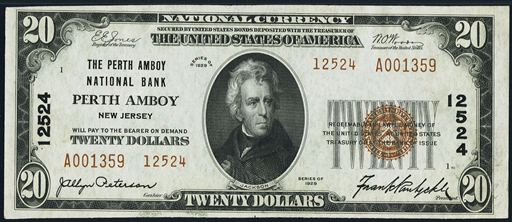The First National Bank Of Roswell
The First National Bank Of Roswell in New Mexico printed $1,579,930 dollars worth of national currency. Over $1,000,000 face value is a lot of money. However, some types and denominations of currency from this bank could still be rare. This national bank opened in 1899 and stopped printing money in 1935, which equals a 37 year printing period. That is a fairly normal lifespan for a national bank. During its life, The First National Bank Of Roswell issued 12 different types and denominations of national currency. We have examples of the types listed below. Your bank note should look similar. Just the bank name will be different. For the record, The First National Bank Of Roswell was located in Chaves County. It was assigned charter number 5220.
We buy all national currency. Please call or email us for a quote. Sales@AntiqueMoney.com
The First National Bank Of Roswell in New Mexico printed 2,670 sheets of $10 1882 territorial brown back national bank notes. Many territorial banks had outputs in the 2,000 to 4,000 range. The ten dollar 1882 territorial brown back was printed by more than 200 national banks, and more than 200 pieces are known to exist today. That number tends to go up by a handful each year as more are discovered. Often times the $10 territorial was the first and lowest denomination a bank received. About a dozen #1 specimens are held by collectors today, and there are probably many more still held by descendants of early pioneer bankers. Territorial bank notes are the cream of the crop when it comes to national bank notes. Most are at least rare and some can be very valuable. As always, the exact value is still based on bank of issue and condition. Something ugly from Oklahoma might only be worth $3,000, but other examples could be worth well over $10,000.
Series of 1882 $10 Territorial Brown Back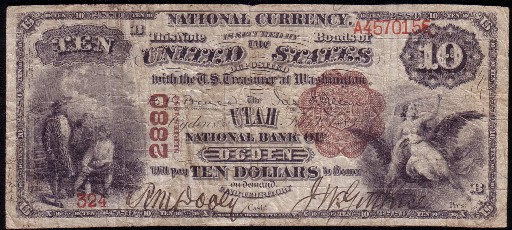
The First National Bank Of Roswell printed 2,670 sheets of $20 1882 territorial brown back national bank notes. That number also represents the total number of twenty dollar bills printed for the type. Whether you have a ten or a twenty dollar territorial brown back, you should work with an expert to establish the value. Twenty dollar notes from this series were only printed at the rate of one to three compared to tens, but sadly, $20 1882 brown backs really don’t command a premium for their extra rarity. Only around fifty are known to exist today.
Series of 1882 $20 Territorial Brown Back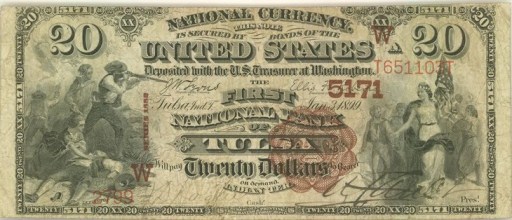
The First National Bank Of Roswell also printed 1,900 sheets of $10 1882 territorial blue seal national bank notes. A total sheet output in the lows 1,000s is a great sign that you own a very rare bank note. You can take that sheet number and multiply it by three to get the exact number of 1882 $10 territorial date backs issued by this bank. Only sixteen different banks even printed this exotic issue. The reason for such a low output has to do with timing. 1882 date backs were not issued until 1908. The only places that were still in territorial status at the time were New Mexico, Arizona, Alaska, and Hawaii. Furthermore, to even qualify to issue these notes the bank had to have been opened between 1888 and 1901. You can see why only sixteen banks ended up printing ten dollar bills like this. Most people who aren’t collectors aren’t entirely sure if they have a territorial or not because non-territorials look exactly the same. Just look below the bank’s title. If it says Territory or Ter before the name of the state, then you have a territorial.
1882 Blue Seal $10 Territorial National Bank Note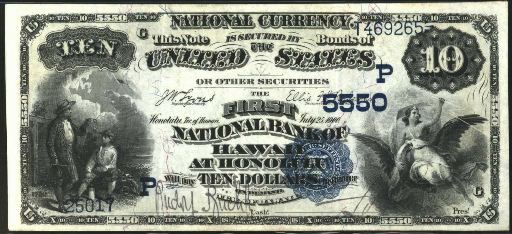
The First National Bank Of Roswell also printed 1,900 sheets of $20 1882 territorial blue seal national bank notes. There was just one twenty dollar bill on each sheet of bank notes. So the sheet number is the same as the individual note output. Currently there are about a dozen 1882 $20 blue seals known to exist. Most of that total is from Hawaii, but Arizona, Alaska, and New Mexico each have single examples to represent the state (or in this case, territory). The design of these notes is just like any other 1882 $20 date back. The left hand side of the note has a man pointing a rifle. The right hand side shows lady liberty or Columbia holding a flag.
1882 Blue Seal $20 Territorial National Bank Note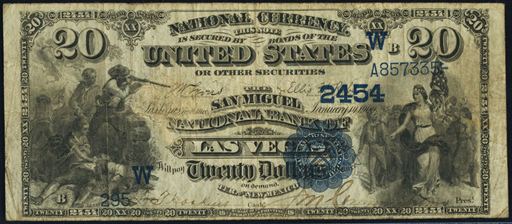
The First National Bank Of Roswell also printed 5,500 sheets of $10 1882 blue seal national bank notes. That is a pretty standard sheet output number for these issues. Most of the value is going to be in the condition. All of these notes say series of 1882 but they were actually printed between 1908 and 1921. So they aren’t quite as old as the dates might suggest. There is also a date on these notes that is between 1888 and 1901. That date is written in cursive text and it represents when the bank was chartered or re-chartered. Some of the so called 1882 value back notes have a chance to be really rare. Most of the earlier notes that say 1882-1908 on the back are likely going to be relatively common. The designs are exactly the same on the front. Each has a blue seal and charter number.
1882 Blue Seal $10 National Bank Note
The First National Bank Of Roswell also printed 5,500 sheets of $20 1882 blue seal national bank notes. That is the same number of sheets as the ten dollar denomination. You don’t have to multiply by three to get the exact number of notes issued though. There was only one twenty dollar bill per sheet. As with any national bank note, the exact value is still based on the condition, serial number, and bank of issue.
1882 Blue Seal $20 National Bank Note
The First National Bank Of Roswell also printed 14,572 sheets of $10 1902 blue seal national bank notes. Once a bank prints more than 10,000 sheets of blue seals it becomes very difficult for those notes to be rare. 1902 $10 blue seal bank notes all have a portrait of William McKinley on them. Values can range from as little as $40 up to over $10,000. There really is no trick to know what is rare and what is common by just doing an internet search. You really need to work with an expert (like us) in order to determine the value of your specific bank note. There are at least ten different factors than can make some 1902 $10 blue seals worth more than others. We know exactly what to look for and we would be happy to provide a free appraisal and our best offer.
1902 $10 Blue Seal National Bank Note
The First National Bank Of Roswell also printed 14,572 sheets of $20 1902 blue seal national bank notes. The same rarity rules for 1902 $10 blue seals also apply to $20 blue seals. Just remember that $20 bills are by nature three times rarer (unfortunately they don’t command a premium over other denominations). Hugh McCulloch is pictured on the front of each bill. Contact us if you need pricing help.
1902 $20 Blue Seal National Bank Note
The First National Bank Of Roswell also printed 3,044 sheets of Type1 1929 $10 national bank notes. That is a pretty typical sheet output for a national bank during the small size era. Each $10 bill from 1929 has a portrait of Alexander Hamilton on it. The black number written vertically is the charter number. The charter number never affects the value; it is just an identifier. The ten dollar type1 national bank note happens to be the single most common national bank note, with over 65,000 known to exist from all banks. Of course each note is valued based on its condition and rarity. Some are very rare.
Series of 1929 Type1 $10 National Bank Note
The First National Bank Of Roswell also printed 896 sheets of Type1 1929 $20 national bank notes. This is a small print range, but it does not guarantee rarity. Andrew Jackson is featured on the front of each 1929 $20 bill. Be sure to take note of the serial number on your specific bank note. If it is 000001 then you can expect a nice premium. There is a special market for serial number one bank notes. Of course, even if the number isn’t #1, it could still be collectible and have a high value just based on its condition and rarity alone.
Series of 1929 Type1 $20 National Bank Note
The First National Bank Of Roswell also printed 3,379 individual notes from the type2 1929 $10 national bank note series. That may seem like a high number, but remember that is total notes printed for the denomination, not sheets printed. The easiest way to spot the difference between type1 1929 $10 bills and 1929 type2 $10 bills is in the serial number. Type2 notes have a serial number that ends with a number. 1929 type1 notes have a serial number that ends with the letter A. Generally speaking, these $10 bills are rarer than the earlier type1 issues. However, most collectors don’t pay more for that rarity because they look basically the same.
Series of 1929 Type2 $10 National Bank Note
The First National Bank Of Roswell also printed 1,194 individual notes from the type2 1929 $20 national bank note series. That may seem like a high number, but remember that is total notes printed for the denomination, not sheets printed. One of the great things about 1929 type2 $20 national bank notes is that they really aren’t that old and some can be extremely rare. Until the big head $20 series started there really wasn’t much difference between something printed in 1929 and the same bill printed in 1993. We have bought some examples in the past few months that people just found in their change.
Series of 1929 Type2 $20 National Bank Note